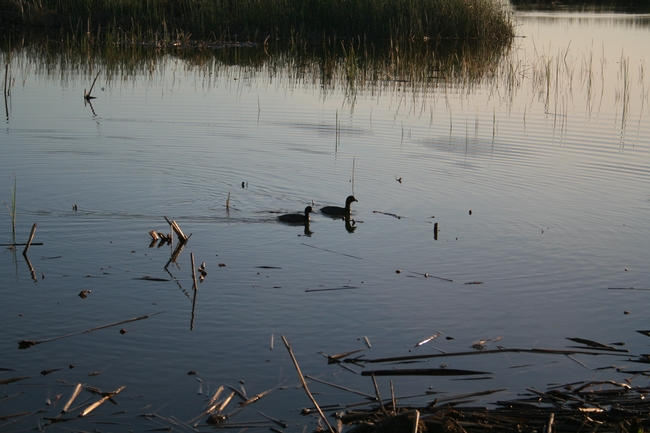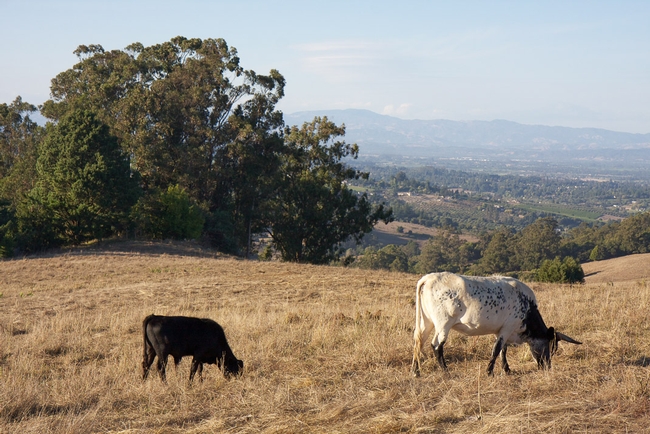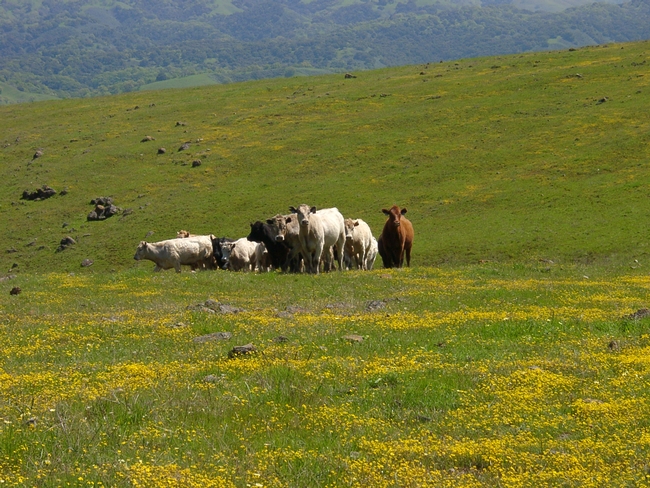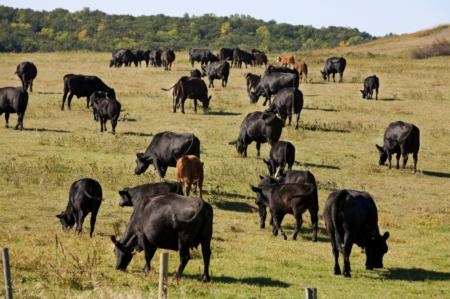Posts Tagged: grazing
UCCE advisors promote targeted grazing to reduce wildfire threat
The natural magic of grazing at the Table Mountain Ecological Reserve in Butte County is made possible by running cattle in targeted areas for carefully planned periods of time, reported Ashiah Scharaga in the Chico News & Review.
"If we reduce the amount of vegetation that is there through livestock grazing, we can reduce the amount of fuels that would be available to help a fire spread and carry and build up intensity," said Tracy Schohr, UC Cooperative Extension livestock and natural resources advisor in Butte, Plumas and Sierra counties.
Targeted grazing, Schohr said, also keeps down grasses, weeds and invasive species, serving as an element in the land management "toolbox."
"If cattle were not actually on Table Mountain Ecological Reserve, essentially those invasive species would choke out those native plants, and they wouldn't be there," Schohr said.
In the past, grazing was considered destructive, however, perspectives have changed with fire science research. One such researcher is Kate Wilkin, the fire science and natural resources advisor for UCCE in Butte, Yuba, Sutter and Nevada counties.
Wilkin said that there has been a long history of grazing in the West, dating to the 1700s. Livestock historically overwhelmed the environment, causing degradation to wetlands and meadows especially. Using animals in a targeted way, however, can reduce fire risk without destroying the natural landscape.
Schohr and Wilkin will host a day-long Irrigated Pasture and Annual Rangeland Management Workshop May 31 at the Chico State University Farm.
Grazing is good for public lands
The author, Sheila Barry, the natural resources and livestock advisor for UC ANR Cooperative Extension in the Bay Area, wrote that overgrazing and impacts to riparian woodlands are legitimate concerns, but have been effectively addressed with modern range management practices. Ranchers can minimize harmful impacts by maintaining proper stocking rates, creating riparian pastures, limiting grazing in sensitive areas and adding off-stream water sources.
Barry delineated a series of beneficial impacts of cattle grazing on Bay Area parklands. She said grazing minimizes wildfire hazards, manages non-native annuals, prevents thatch build up, promotes flowering plants, and improves carbon sequestration.
Barry added that no documented plant or animal species extinction has been linked to cattle grazing in California. On the contrary, numerous threatened and endangered species rely on grazing and rancher stewardship, including Santa Cruz tar plant, Contra Costa goldfields, Sonoma spineflower, San Joaquin kit fox, California tiger salamander, California red-legged frog, Ohlone tiger beetle, and Bay checkerspot and Callippee silverspot butterflies.
The magazine also included a "con" argument, written by Karen Klitz, a member of the Western Watersheds Project board of directors, and Jeff Miller, a conservation advocate with the Center for Biological Diversity and director of the Alameda Creek Alliance. The authors say grazing is incompatible with conservation because damage wrought by livestock is not a thing of the past. Klitz and Miller cite research showing that removing cattle can restore trout populations, native songbirds, wildflowers and amphibians. Grazing cessation at Mount Diablo State Park decreased weedy species and increased native grassland species and supports 16 rare or endangered wildlife species, the article said.
Grazing public lands is compatible with recreation, UC scientists say
The media coverage was one of numerous stories that have appeared around the country about the research, including Bloomberg, Cattle Network, Progressive Cattle, Science Daily, AgWeb and the UC Green Blog.
The study was conducted from June to November 2011. Nearly 40 UC Davis researchers, ranchers, U.S. Department of Agriculture Forest Service staff and environmental stakeholders went out by foot and on horseback, hiking across meadows, along campsites, and down ravines to collect 743 water samples from 155 sites across five national forests in northern California.
The scientists found that recreation sites were the cleanest, with the lowest levels of fecal indicator bacteria. They found no significant differences in fecal indicator bacteria between grazing lands and areas without recreation or grazing. Overall, 83 percent of all sample sites and 95 percent of all water samples collected were below U.S. Environmental Protection Agency benchmarks for human health.
Caltrans to cooperate with UCCE on long-term rangeland practices study
A settlement between Caltrans and the California Farm Bureau Federation, which resulted in CFBF dismissing a lawsuit against Caltrans about the Willits Bypass Project, includes a long-term wetlands study by UC Davis and UC Cooperative Extension researchers, according to Caltrans and farm bureau press releases issued last week.
Caltrans is building a bypass along U.S. Route 101 around the community of Willits. The project will relieve congestion, reduce delays, and improve safety for traffic and pedestrians, Caltrans said. CFBF filed the lawsuit because of concern about how the project would impact farmland in the Little Lake Valley.
"Specifically, Farm Bureau was concerned about the amount of farmland the U.S. Army Corps of Engineers mitigation strategy required to be removed from production in order to mitigate for wetlands affected by the bypass," the CFBF press release said.
According to the terms of the agreement noted in both press releases, Caltrans will cooperate with UC Davis and UCCE to study how grazing management contributes to enhanced wetland function.
The study will look at land owned by the state — where grazing is required — and federally owned land — where grazing is prohibited — and consider how to optimize grazing productivity while achieving the desired wetlands enhancements. The research will provide an opportunity to study how natural resources can be preserved and land utilized for both grazing and wetlands.

UC researchers will study how to optimize grazing productivity while achieving desired wetlands enhancements.
Rangelands could offset tons of carbon emissions
With proper management, already productive California rangeland could single-handedly offset the state's carbon emissions, believe researchers involved in The Marin Carbon Project.
The ongoing effort was covered by the San Rafael/Terra Linda News Pointer in connection with a Bioneers Conference taking place Oct 15-17 at San Rafael’s Marin Center.
The Marin Carbon Project was formed to establish the basis for rangeland soil carbon sequestration. Initiated two years ago, the project involves ranchers and researchers representing UC Berkeley, UC Davis, UC Cooperative Extension, Marin Organic, Marin Agricultural Land Trust, Marin Resource Conservation District, the USDA Natural Resources Conservation Service, Nicasio Native Grass Ranch, the Marin County Agriculture Commissioner and the Environmental Defense Fund.
Soil surveys to establish pre-existing levels of carbon in Marin rangeland soils have been completed. This baseline data will allow the accurate assessment of how much carbon improved management practices sequester over time.
For example, project co-founder John Wick told reporter Anna McCarthy that composting wet dairy manure with greenwaste and spreading it on rangelands increases rangeland production and reduces the risk of pathogen runoff into waterways. The practice also "turns the land into a carbon sucking machine," McCarthy wrote.
“It works,” Wick was quoted. “And it works at such a rate, it’s phenomenal.”
A year after adding a half-inch dusting of compost to his rangelands, Wick said the soil yielded 10 tons of carbon per hectare (10,000 square meters).
“That rate, applied on one-third of California’s rangeland, would offset all of California’s emissions every year,” Wick told the reporter.

The Marin Carbon Project seeks to document carbon sequestration in rangeland.



